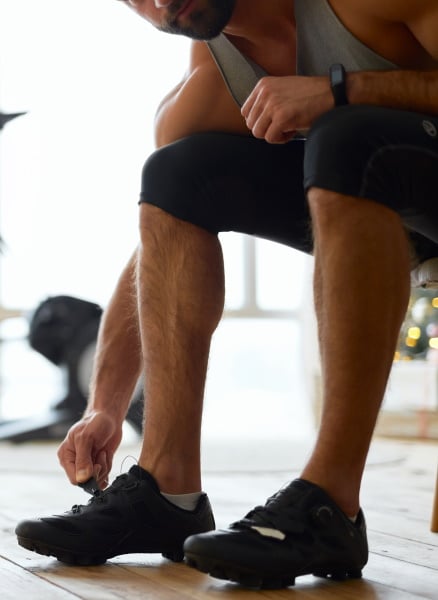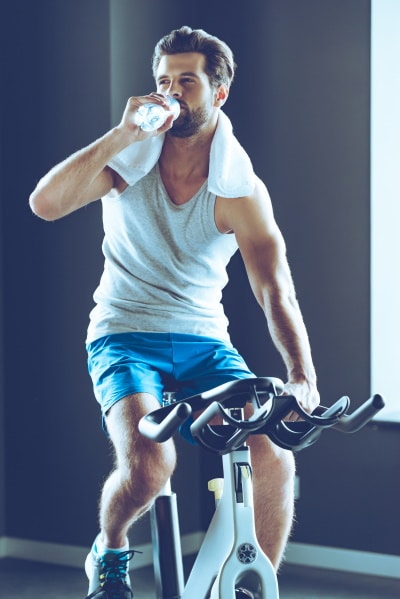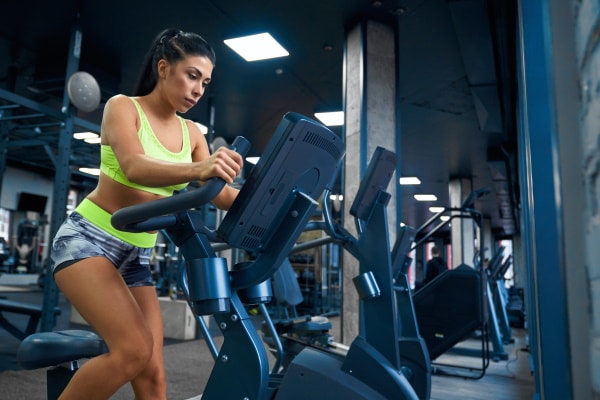The Peloton bike is a stationary bike. It isn’t just any old exercise bike, though. Peloton members have access to various workouts, including rides, strength training, and yoga. The result is a community that is dedicated to inspire and motivate. To be inspired and motivated.
Peloton Interactive Inc. sells various pieces of exercise equipment, accessories, and apparel. While you don’t need many accessories or even specific clothing to use your Peloton spin bike, you will need special cycling shoes that are compatible with your Peloton bike’s pedals.
Peloton bike pedals are clipless – meaning that you need to use cycling shoes that clip into the pedals. The name may be confusing since these shoes clip into your pedals. In the past, people used toe cages (or toe clips) to keep their feet secured to their pedals.
Toe cages are a series of straps or rubber or plastic strips that form a kind of basked (or cage) for your toes. You would then slip your foot into the cage, and this would hold your foot securely on the pedal. Because these were already called ‘clips,’ they needed a way to differentiate between these clips and shoes that connect to your pedals with a cleat. Cleated shoes thus became ‘clipless.’
Clipless Peloton pedals can only be used with three-bolt Look Delta Cleats. These cleats are triangular to accommodate the three bolts – that is also where they got their name. Unfortunately, you cannot use other types of cleats or regular sneakers with these pedals.
Peloton bike pedals have a one-year warranty, but this warranty only covers the original owner or the original owner of the membership attached to a specific bike. The warranty is also only valid if a Peloton technician services or carries out any other work on your Peloton bike. In the case of your pedals, that needs to be done once a year.
Table Of Contents
What shoes can be used with a Peloton bike?

You don’t need to use Peloton branded shoes to ride your Peloton bike. However, you need cycling shoes or spin shoes that can accommodate Look Delta cleats. These are the only type of cleats that can be used with the original Peloton bike pedals. Peloton cycling shoes come with these cleats, as do some other brands.
While Peloton shoes come with Look Delta cleats, other brands might not sell the cleats with their cycling shoes. In this case, you will need to purchase the shoe and the cleats separately. Some shoes can accommodate both Look Delta and SPD cleats.
What are the benefits of clipless bike pedals?
Some people are apprehensive about riding clipless. There is something slightly unsettling about being connected to your bike pedals – at least at first. Having your foot secured to your bike pedal is safer, especially during more intense rides. There is a lower risk of your foot slipping off the pedal, leaving the spinning pedal to connect with your shin and potentially giving you a serious lower leg injury.
Clipless peddling means you don’t need to constantly work at keeping your foot on the pedal. This can reduce foot fatigue and discomfort that is commonly caused by constantly pushing your foot down against the pedal. The end result is that your feet are less tired and sore after long or intense rides.
Cycling cleats (especially the higher-end ones made with carbon outsoles) are stiff underneath. This provides more support for your feet and toes while transferring more energy to your pedals.
Being clipped in gives many cyclists a feeling of ‘being one’ with their bike. The pedals and crank arm essentially become an extension of their bum, legs, ankles, and feet. Your energy is used more efficiently because you don’t only keep the pedaling going when you push down on the pedals; you also pull up on them.
Because you are both pushing down and pulling up, you are not only working your quads. Every upward pull and set up works your glutes and hamstrings. Therefore, you get a better-rounded workout when cycling while clipped in.
A disadvantage of having clipless pedals is that only persons who have compatible cycling shoes can use the bike. That is unless the pedals can accommodate toe clips.
How to clip in and out of your Peloton pedals
Straddle your bike with one foot on each side. First click in your dominant side before switching to the other foot. While standing, push the pedal down so that it is at its lowest position (around 6 O’clock). Place your foot on the Look Delta pedals with your toes slightly pointed down. This will help you find where the front of the clip needs to fit in. Once you have the right location, press down with your heel. The cleat will clip into the pedal with an audible ‘click.’ You can then clip in the other foot. This can be done either standing up or sitting down. Make sure that your cleat is correctly clipped by wiggling your foot from side to side. There should be a very small amount of movement.
To unclip, simply swivel your heels out, away from the bike frame. You may need to use moderate force to do this, and you are likely going to feel some resistance. It could also be a bit easier to unclip if you slightly lift your heel. It is best to unclip one foot at a time. You can unclip both feet while sitting down. Alternatively, you can unclip one foot and unmount towards the side of the foot that is still clipped. Then unclip your other foot while standing securely on the floor with the foot that has already been unclipped.

Holding on to or pushing down on the resistance knob while putting some of or even your full weight on the pedal could make clipping and unclipping easier.
You will notice that the pedal has a tension screw underneath the area where you clip your cleat in. Peloton’s recommendation is not to loosen this screw since it could damage the pedal.
Servicing and maintaining your Peloton pedals
You need to do some maintenance to make sure your Peloton bike pedals continue to work correctly and safely and to avoid pedal breakage. Peloton recommends that you inspect your bike’s pedals at least once a month. During this inspection, look for any visible damage, ensure that the pedals are clean, and turn smoothly.
You may need to tighten your Peloton pedals every now and then. This is to make sure that they are still securely attached to the bike. To do this, turn the resistance knob all the way to the right. This will lock the flywheel and crank.
Hold the pedal level – the platform on which you rest your foot while cycling (called the pedal body) should be horizontal. Use a 15mm wrench to tighten the bolt that attaches the pedal to the crank arm. You will turn the wrench to your right (or clockwise) when tightening the right pedal. The left pedal has a reverse thread. The threads are different so that neither pedal loosens itself while you are pedaling forwards and backward. For the left pedal, you need to turn the wrench to the left or towards the front of the bike (or counterclockwise).
Turn the wrench until you cannot turn it anymore. That is how you will know that the pedal is secure.
Peloton bike pedals could fail due to wear and tear. Although the pedals come with a 12-month warranty, you may need to replace them more often, especially if you work out often and do many long or intense rides. To replace your Peloton pedals, you will need a set of new pedals, a 15mm wrench, and (or) a 6mm Allen key.
To remove your Peloton pedals, turn the resistance knob all the way to the right. Next, use a 15mm wrench to remove the pedals where they attach to the crank arm. Turn the wrench counterclockwise for the right pedal and clockwise for the left pedal. Some Peloton bike pedals need to be removed with a 6mm Allen key. To remove the right pedal, turn the Allen key counterclockwise. The left pedal is removed by turning the Allen key clockwise.
To attach the right pedal, insert the pedal into the crank arm (remember that these need to be 9/16” pedals if you are not replacing your pedals with Peloton pedals). Then turn the pedal a quarter of a turn counterclockwise, so the threads catch. This will avoid damaging the threads because they don’t align. Next, turn the pedal clockwise until you can no longer turn it by hand. Lastly, use a 15mm wrench to tighten the pedal securely. You need to turn the wrench clockwise until you can’t turn it anymore.
Installing the left pedal follows the same steps. Remember that this side has reverse threads, so you will need to turn the pedal clockwise for the threads to catch and then tighten it by turning the pedal (or wrench) counterclockwise.
Keep in mind that you are not turning the pedal in each of these instances. Instead, you need to turn the bolt that attaches the pedal to the crank arm. You also need to remember that the left and right pedals have different threads. Take a look to see whether the pedals are marked ‘Left’ and ‘Right.’ If not, you will quickly realize that you are working with the wrong pedal if it does not tighten when you turn it in the correct direction.
You may need to adjust your pedal tension from time to time. The tension screws hold your cleats securely to your pedal. These screws are located on the back (or bottom) of the pedals. You may need to do this if it is your first time clipping in and unclipping with new pedals and you are finding it difficult to do so. You might also need to adjust the pedal tension if your cycling shoes begin to feel loose in the pedals.
To adjust your pedal tension, turn the resistance knob all the way to the right to hold the flywheel and crank arms in place. Turn the pedal so that you can see the screws that are located on the bottom. The tension screw on each pedal has a plus and minus sign above it.
If it is too difficult to clip in to or out of your pedals, you can loosen this screw slightly. Remember that loosening it too much could damage the pedal or cause it to not function properly. Use a 3mm Allen key. Turn the Allen key counterclockwise towards the minus sign. Only loosen the screw fractionally - a quarter of a turn at a time. Try to clip in and clip out after each turn. Remember that you still need to use some pressure or force to clip and unclip. If it is too easy, you loosened the screw too much.
If your cycling shoes feel too loose in the pedals, or if it is too easy to clip and unclip, the tension screw needs to be tightened. In this case, you will use the Allen key to turn the screw clockwise towards the plus sign. Turn the screw a quarter of a turn at a time and try to clip in after each quarter turn. Do this until you need to use some force to clip in and unclip.
Peloton pedal conversion kits
Older models of Peloton bikes came with a conversion kit that had toe cages clipped onto them. Peloton pedal conversion kits that are SPD-cleat compatible on one side and a toe cage on the other are now only available for commercial Peloton bikes. That is: hotels and fitness centers that have Peloton bikes for their guests or members to use.
You can find toe cages that could work with existing Look Delta Peloton pedals. These toe cages often attach to the crank arm or the pedal itself, depending on the pedal and the toe cage. They usually have a small platform that fits on top of your bike’s pedal which makes the platform slightly larger and thus safer to use without clipless cycling shoes.
You can also find toe cages that attach to a Look Delta cleat, the part that usually attaches to your shoe. This modified cleat then gets clipped into the pedal as you would do with your cleated cycling shoes. Cyclists then only need to slip their trainers into the toe cage to get the benefit of cycling with their feet attached to the pedal.
Using other, non-Peloton, pedals on your Peloton bike
You can change out your Peloton bike pedals for other pedals if you want to use SPD shoes that you already own. You may also want to do this if you might have guests or family members who prefer cycling with sneakers fitted into toe clips or on flat pedals. Most SPD pedals can be used on a Peloton bike – they just need a spindle thread of 9/16”.
Remember that if you do change out your Peloton bike’s pedals, it could affect the warranty of the pedals and related parts.
Recalled Peloton Pedals
Some older Peloton models that were purchased between July 2013 and May 2016 are affected by a recall. This is because the axles of these bikes could break unexpectedly. The recalled pedals reportedly broke under pressure. This was reported by 120 persons – 16 of whom sustained leg injuries. Although only five individuals required medical care.
The recalled pedals is the PR70P model. You can identify these pedals by looking for two Peloton logos along with the word ‘PELOTON’ written next to them. One of these is black and molded into the body of the pedal. The other is located on the top of the cleat binding and has an orange Peloton symbol with the word ‘PELOTON’ written in white lettering next to it.
The recall only affects Peloton bikes bought between July 2013 and May 2016 that still have the pedals originally installed on the bike. Pedals with only white lettering and no orange logo next to them are not subject to the recall.
If your bike has these pedals, Peloton will send you a free pair of replacement pedals. You can self-install the new pedals or hire a Peloton technician to do this for you. Getting a Peloton technician out will cost you $100.
Peloton bike pedals are clipless pedals that accommodate Look Delta cleats. Although you do not need to use Peloton branded shoes with your Peloton bike, you will need to have a pair of cycling shoes with Look Delta cleats.
Using clipless pedals can offer you a better-rounded and safer workout. It is easy to maintain your Peloton pedals. It is equally easy to replace these pedals when you need to. Alternatively, you could install SPD compatible pedals if you want to use your SPD cycling shoes or prefer using toe cages. If you do this, remember that it may affect your Peloton pedal warranty.

